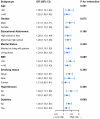Association between body roundness index and advanced cardiovascular-kidney-metabolic syndrome
- PMID: 40808842
- PMCID: PMC12343269
- DOI: 10.3389/fnut.2025.1623766
Association between body roundness index and advanced cardiovascular-kidney-metabolic syndrome
Abstract
Background: Cardiovascular-kidney-metabolic (CKM) syndrome is a disease characterized by interrelated cardiovascular, renal, and metabolic abnormalities. The body roundness index (BRI) is an innovative anthropometric index that characterizes human body shape by calculating body roundness and using eccentricity to estimate visceral and total body fat percentages. The present study aimed to clarify the relation between BRI and advanced CKM syndrome.
Methods: Data were obtained from the National Health and Nutrition Examination Survey conducted between 2005 and 2018. Tertiles based on data analysis were applied to divide the levels of BRI. Regression methods assessed the association of BRI with the risk of advanced CKM syndrome. Moreover, receiver operating characteristic analysis determined BRI's predictive performance for such a syndrome.
Results: The present study included 12,329 participants, with an advanced CKM occurrence rate of 12.20%. Regression analysis revealed a positive association between BRI and advanced CKM syndrome. After adjusting for covariates, individuals in the highest BRI tertile (T3) showed a significantly higher prevalence of advanced CKM syndrome compared to the reference group (odds ratio: 1.49; 95% confidence interval: 1.09-2.03, p < 0.001). Smoothed curve-fitting analyses showed a linear trend. Subgroup analyses yielded results consistent with the total results. Furthermore, restricted cubic spline analyses indicated that BRI was a stronger predictor of advanced CKM syndrome than other anthropometric measures.
Conclusion: An increased BRI is associated with a higher occurrence rate of advanced CKM syndrome. BRI demonstrated a stronger correlation with advanced CKM than traditional measures and warrants consideration as a preferred metric for CKM risk stratification.
Keywords: CKM; NHANES; RCS; body roundness index; obesity.
Copyright © 2025 Chen, Tu, Liang and Shen.
Conflict of interest statement
The authors declare that the research was conducted in the absence of any commercial or financial relationships that could be construed as a potential conflict of interest.
Figures




Similar articles
-
Association between visceral lipid accumulation indicators and advanced cardiovascular-kidney-metabolic syndrome: a cross-sectional study based on NHANES 1999-2018.Cardiorenal Med. 2025 Jul 21:1-30. doi: 10.1159/000547533. Online ahead of print. Cardiorenal Med. 2025. PMID: 40690909
-
Altered albumin/neutrophil to lymphocyte ratio are associated with all-cause and cardiovascular mortality for advanced cardiovascular-kidney-metabolic syndrome.Front Nutr. 2025 Jul 16;12:1595119. doi: 10.3389/fnut.2025.1595119. eCollection 2025. Front Nutr. 2025. PMID: 40740647 Free PMC article.
-
Mediating Effects of Systemic Inflammation on the Association Between Body Roundness Index and Periodontitis in US Adults.Int Dent J. 2025 Aug;75(4):100832. doi: 10.1016/j.identj.2025.04.012. Epub 2025 Jun 10. Int Dent J. 2025. PMID: 40499289 Free PMC article.
-
Effectiveness of Body Roundness Index (BRI) and a Body Shape Index (ABSI) in Predicting Hypertension: A Systematic Review and Meta-Analysis of Observational Studies.Int J Environ Res Public Health. 2021 Nov 4;18(21):11607. doi: 10.3390/ijerph182111607. Int J Environ Res Public Health. 2021. PMID: 34770120 Free PMC article.
-
Effectiveness of body roundness index for the prediction of nonalcoholic fatty liver disease: a systematic review and meta-analysis.Lipids Health Dis. 2025 Mar 27;24(1):117. doi: 10.1186/s12944-025-02544-3. Lipids Health Dis. 2025. PMID: 40148946 Free PMC article.
References
-
- Usman MS, Khan MS, Butler J. The interplay between diabetes, cardiovascular disease, and kidney disease In: Butler J, editor. Chronic kidney disease and type 2 diabetes. Arlington, VA: American Diabetes Association; (2021) - PubMed
-
- Ndumele CE, Neeland IJ, Tuttle KR, Chow SL, Mathew RO, Khan SS, et al. A synopsis of the evidence for the science and clinical management of cardiovascular-kidney-metabolic (CKM) syndrome: a scientific statement from the american heart association. Circulation. (2023) 148:1636–64. doi: 10.1161/CIR.0000000000001186, PMID: - DOI - PubMed
LinkOut - more resources
Full Text Sources
Miscellaneous

